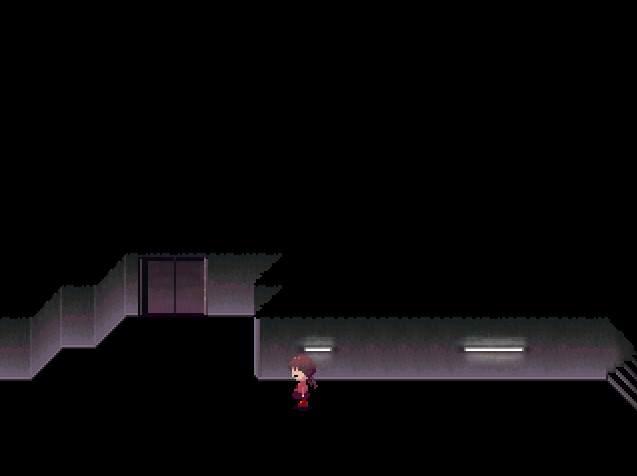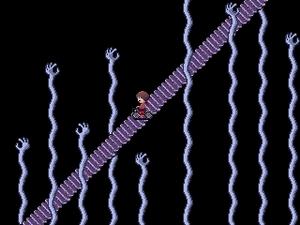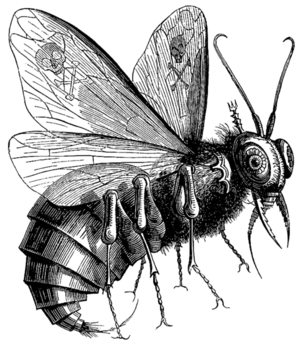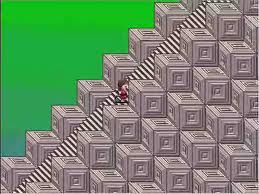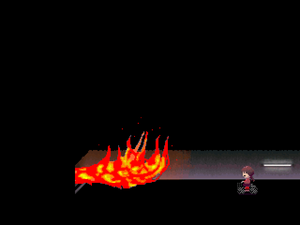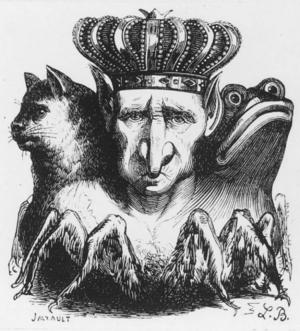The Staircase of Hands(Harrowing of Hell)
The Harrowing of Hell (Latin: Descensus Christi ad Inferos, "the descent of Christ into hell") is the Old English and Middle English term for the triumphant descent of Christ into Hell (or Hades) between the time of his Crucifixion and his Resurrection when he brought salvation to all of the righteous who had died since the beginning of the world (excluding the damned).[1]
※1 Flew to the East(Easter) of The Mall Rooftop, dropped down and go back to Madotsuki's bed ⇒ resurrection of Madotsuki (Easter) ⇒ Effects(Easter egg).
※2 Poop Hair(Beelzebub) ⇒ Beelzebub(one of the seven princes of Hell) ⇒Hell(The Underground World)
Poop Hair(Beelzebub)
Beelzebub or Beel-Zebub (Hebrew: בַּעַל זְבוּב, Baʿal Zəvûv; Arabic: بعل الذباب, Ba‘al adh-Dhubāb; literally "Lord of the Flies" (which originally meant "Lord of everything that flies"); Greek: Βεελζεβούλ, Velzevoúl; Latin: Beelzebūb), with numerous archaic variants,[1] is a Semitic deity that was worshiped in the Philistine city of Ekron.
※1 Poop Hair(Madotsuki drops a fly which buzzes around in place ) ⇒Beelzebub("Lord of the Flies")
In later Christian and Biblical sources, he is referred to as another name for Devil,[2] and in Catholic demonology, is one of the seven princes of Hell according to Catholic views on Hell.
※2 Poop Hair(Beelzebub) ⇒ Beelzebub(one of the seven princes of Hell) ⇒Hell(The Underground World)
The source for the name Beelzebub is in 2 Kings 1:2-3, 6, 16. Ba‘al Zəbûb is variously understood to mean "lord of the flies"[3][4][5][6] or "lord of the (heavenly) dwelling".[7][8][9]
8 The Wilderness(Ark of the Covenant)
※3 Poop Hair(Beelzebub is in 2 Kings 1:2-3, 6, 16) ⇒ The Wilderness(See 1 Kings and 2 Kings at Bible Gateway is in 1 Kings 6:1–38)
The Underground World(Christian views on Hell)
Christian views on hell generally hold it to be place or a state in which the souls of the damned suffer the consequences of their sins.
3 The Underground World(Christian views on Hell)
※2 Poop Hair(Beelzebub) ⇒ Beelzebub(one of the seven princes of Hell) ⇒Hell(The Underground World)
The Book of Revelation contains the image of a "lake of fire" and "burning sulphur" where "the devil, the beast, and false prophet" will be "tormented day and night for ever and ever" (Revelation 20:10) along with those who worship the beast or receive its mark (Revelation 14:11).[25]
※Hell(The Underground World) ⇒The Underground World(Lake of fire)
The Underground World(Lake of fire)
A lake of fire appears, in both ancient Egyptian and Christian religion, as a place of after-death destruction of the wicked. The phrase is used in four verses of the Book of Revelation.
※2 Poop Hair(Beelzebub) ⇒ Beelzebub(one of the seven princes of Hell) ⇒Hell(The Underground World)
An image[2] in the Papyrus of Ani (ca. 1250 BC), a version of the Book of the Dead, has been described as follows:
- The scene shows four cynocephalous baboons sitting at the corners of a rectangular pool. On each side of this pool is a flaming brazier. The pool's red colour indicates that it is filled with a fiery liquid, reminding one of the "Lake of Fire" frequently mentioned in the Book of the Dead.[3]
The 1995 edition of the International Standard Bible Encyclopedia says that the Egyptian lake of fire is too remote to be relevant to the use of "lake of fire" in the Book of Revelation.
[4]※The Underground World(Lake of fire) ⇒ On each side of this pool is a flaming brazier ⇒ flaming brazier(Lizard) ⇒NASU(Hopi's motif)
Poop Hair(Brazier (hieroglyph))
The Ancient Egyptian Brazier hieroglyph is Gardiner sign listed no. Q7 for the cooking brazier. It is shown from the Old Kingdom in the style of a vertical burning flame upon four feet, but the hieroglyph has the flame hiding the fourth foot. Another Gardiner unlisted form has the four feet, with no flame, and in a plan view.
※The Underground World(Lake of fire) ⇒ Brazier hieroglyph(the Old Kingdom in the style of a vertical) burning flame ⇒ flaming brazier(Lizard) ⇒ NASU(Hopi's motif)
Poop Hair(Dictionnaire Infernal)
The Dictionnaire Infernal (English: Infernal Dictionary) is a book on demonology, organised in hellish hierarchies.
13.Bael
18.Belzebuth
※Poop Hair(Belzebuth) ⇒ Poop Hair(Dictionnaire Infernal) ⇒ Poop Hair(Baal (demon))
Poop Hair(Baal (demon))
Baal (/ˈbeɪl/ BAYL; sometimes spelled Bael, Baël (French), Baell) is in 17th Century goetic occult writings one of the seven princes of Hell. The name is drawn from the Canaanite deity Baal mentioned in the Hebrew Bible as the primary god of the Phoenicians.
While his Semitic predecessor was depicted as a man or a bull,[1] the demon Baal was in grimoire tradition said to appear in the forms of a man, cat, toad, or combinations thereof. An illustration in Collin de Plancy's 1818 book Dictionnaire Infernal rather curiously placed the heads of the three creatures onto a set of spider legs.
[2]
※the demon Baal was in grimoire tradition said to appear in the forms of a man, cat, toad

